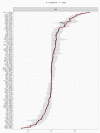Risk and Protective Factors in Adolescent Suicidal Behaviour: A Network Analysis
- PMID: 35162805
- PMCID: PMC8834911
- DOI: 10.3390/ijerph19031784
Risk and Protective Factors in Adolescent Suicidal Behaviour: A Network Analysis
Abstract
Given that death by suicide continues to rank among the top three causes of death during adolescence, new psychological models may contribute critical insight towards understanding the complex interactions between risk and protective factors in suicidal behaviour. The main objective of this study was to analyse the psychological network structure of suicidal behaviour and putative risk and protective factors in school-aged adolescents.
Methods: Stratified random cluster sampling was performed. The final sample comprised 1790 students (53.7% female, M = 15.7 years, SD = 1.26). Instruments were administered to assess suicidal behaviour, emotional and behavioural difficulties, prosocial behaviour, subjective well-being, self-esteem, depressive symptomatology, academic performance, socio-economic status, school engagement, bullying, and cyberbullying.
Results: In the estimated psychological network, the node with the highest strength was depressive symptomatology, and that with the highest expected influence value was bullying. Suicidal behaviour was positively connected to symptoms of depression and behavioural problems. In addition, suicidal behaviour was negatively connected to self-esteem and personal well-being. The results of the stability analysis indicated that the network was accurately estimated.
Conclusions: Suicidal behaviour can be conceptualised as a dynamic, complex system of cognitive, emotional, and affective characteristics. New psychological models allow us to analyse and understand human behaviour from a new perspective, suggesting new forms of conceptualisation, evaluation, intervention, and prevention.
Keywords: adolescents; network; protective factors; risk factors; suicidal behaviour.
Conflict of interest statement
The authors declare no conflict of interest.
Figures




Similar articles
-
Suicidal behaviour in adolescents: A network analysis.Span J Psychiatry Ment Health. 2024 Jan-Mar;17(1):3-10. doi: 10.1016/j.rpsm.2020.04.007. Epub 2020 May 31. Span J Psychiatry Ment Health. 2024. PMID: 32493673
-
Risk and protective factors for suicidal ideation among Saudi adolescents: A network analysis.Int J Soc Psychiatry. 2024 Dec;70(8):1533-1541. doi: 10.1177/00207640241277164. Epub 2024 Sep 4. Int J Soc Psychiatry. 2024. PMID: 39230357
-
Suicidal Behavior in University Students in Spain: a Network Analysis.Brain Behav. 2025 Apr;15(4):e70457. doi: 10.1002/brb3.70457. Brain Behav. 2025. PMID: 40249048 Free PMC article.
-
Risk and Protective Factors of Suicidal Ideation and Attempt among Adolescents with Different Types of School Bullying Involvement.Arch Suicide Res. 2015;19(4):435-52. doi: 10.1080/13811118.2015.1004490. Epub 2015 Nov 13. Arch Suicide Res. 2015. PMID: 26566860
-
[Cyberbullying and Suicidal Behavior: What is the Connection? About a Case].Rev Colomb Psiquiatr. 2017 Oct-Dec;46(4):247-251. doi: 10.1016/j.rcp.2016.08.004. Epub 2016 Oct 5. Rev Colomb Psiquiatr. 2017. PMID: 29122233 Review. Spanish.
Cited by
-
Longitudinal panel networks of risk and protective factors for early adolescent suicidality in the ABCD sample.Dev Psychopathol. 2024 Oct 10:1-17. doi: 10.1017/S0954579424001597. Online ahead of print. Dev Psychopathol. 2024. PMID: 39385600
-
Perceived Stressful Life Events and Suicide Risk in Adolescence: The Mediating Role of Perceived Family Functioning.Behav Sci (Basel). 2024 Jan 3;14(1):35. doi: 10.3390/bs14010035. Behav Sci (Basel). 2024. PMID: 38247687 Free PMC article.
-
Predictive Factors of Suicidal Ideation in Spanish University Students: A Health, Preventive, Social, and Cultural Approach.J Clin Med. 2023 Feb 2;12(3):1207. doi: 10.3390/jcm12031207. J Clin Med. 2023. PMID: 36769853 Free PMC article.
-
Analyzing Co-Occurrence of Non-Suicidal Self-Injury With Suicidal Ideation and Related Factors Among Adolescents in Jeju Island.J Korean Acad Child Adolesc Psychiatry. 2024 Apr 1;35(2):119-126. doi: 10.5765/jkacap.230054. J Korean Acad Child Adolesc Psychiatry. 2024. PMID: 38601107 Free PMC article.
-
Factors Associated with Suicidal Behavior in Adolescents: An Umbrella Review Using the Socio-Ecological Model.Community Ment Health J. 2025 May;61(4):612-628. doi: 10.1007/s10597-024-01368-2. Epub 2024 Nov 2. Community Ment Health J. 2025. PMID: 39487937 Free PMC article.
References
-
- World Health Organization . Preventing Suicide: A Global Imperative. WHO Library; Geneva, Switzerland: 2014.
-
- Al-Halabí S., Fonseca-Pedrero E. Suicidal behavior prevention: The time to act is now. Clin. Y Salud. 2021;32:89–92. doi: 10.5093/clysa2021a17. - DOI
Publication types
MeSH terms
LinkOut - more resources
Full Text Sources
Medical

